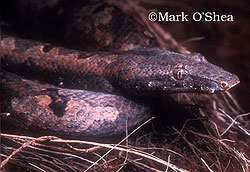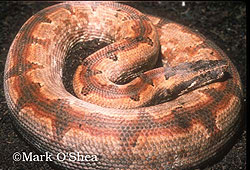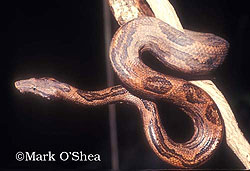Bevel-nosed boas have narrow heads, long prehensile tails and a variable pattern.
Distribution: Eastern Indonesia, Papua New Guinea and Bismarck Archipelago.
Habitat: Coconut plantations and rainforests.
Diet: Lizards and frogs.
Max.length: 0.5-0.6m SVL (0.6-0.7m TL).
Reproductive strategy: Viviparous with 4-6 neonates.
It has been problematic determining what common name to use for Candoia carinata. Specimens that occur in sympatry with the stout New Guinea ground boa C.aspera, as they do on Karkar Island, tend to be slender and arboreal while those occurring in areas from which C.aspera are absent seem to be more stout-bodied and terrestrial. This led to me referring to the slender C.carinata carinata as Pacific tree boas and the stout C.c.paulsoni as Pacific ground boas in my book on the snakes of PNG. A recent taxonomic revision may have helped solve the problem in some respects but may also have made it more complex by introducing a new moniker, bevelnosed boa (see below).

Mark O'Shea
Bevel Nosed Boa
Confining my comments to the Karkar specimens, these are very slender little snakes which were referred to by Sam McDowell as ‘long-tailed C.carinata’. They have narrow heads, long prehensile tails and a variable pattern which differs not only from specimens to specimen but may even vary in a single individual as it changes shade depending on the environmental conditions. Most specimens are blotched or striped but a common characteristic of the New Guinea specimens is the presence of a large pale saddle marking over the back of the snake in the cloacal region. Females lack cloacal spurs in New Guinea and Karkar populations.

Mark O'Shea
Bevel Nosed Boa
Taxonomic note: The recent revision of the Candoia carinata complex, which basically recognized the various populations defined by Sam McDowell, has elevated its two subspecies to full species status and defined eight subspecies between them. In addition a third species, with two subspecies has been described. The form occurring on Karkar Island is the nominate Candoia carinata carinata.
C.carinata (Schneider’s bevelnosed boa) from eastern Indonesia, New Guinea & Bismarcks. C.carinata carinata (Western Schneider’s bevelnosed boa) from east Indonesia & New Guinea. C.carinata tepedeleni (Tepedelen’s bevelnosed boa) from Bismarck Archipelago. C.paulsoni (Paulson’s bevelnosed boa) from eastern Indonesia, New Guinea & Solomons. C.paulsoni paulsoni (Solomon bevelnosed boa) from Solomon Islands, excl. Bougainville. C.paulsoni mcdowelli (McDowell’s bevelnosed boa) from PNG & Louisiade Archipelago. C.paulsoni rosadoi (Rosado’s bevelnosed boa) from Misima Island, Louisiade Archipelago. C.paulsoni sadlieri (Sadlier’s bevelnosed boa) from Woodlark Island, Louisiade Archipelago. C.paulsoni tasmai (Tasma’s bevelnosed boa) Halmahera & northeastern Sulawesi, Indonesia. C.paulsoni vindumi (Vindum’s bevelnosed boa) from Bougainville & Buka. C.superciliosa (Belau bevelnosed boa) from Palau Archipelago. C.superciliosa superciliosa (Northern Belau bevelnosed boa) from Babeldaob to Beliliou. C.superciliosa crombei (Ngeaur bevelnosed boa) from Ngear, southern Palau.
The other species in Candoia are Candoia aspera, from New Guinea, with two subspecies (C.a.aspera and C.a.schmidti), and C.bibroni, from Samoa to the Solomons, also with two subspecies (C.b.bibroni and C.b.australis).

Mark O'Shea
Bevel Nosed Boa
Sources for more information:
Harlow P. & R.Shine 1992 Food habits and reproductive biology of the Pacific island boas (Candoia). Journal of Herpetology 26(1):60-66.
Jacobs P. 1990 Things worth knowing about Candoia carinata carinata and C.c.paulsoni. Litteratura Serpentium 10(2):179-180.
Johnson C.R. 1975 Thermoregulation in the Papuan-New Guinean boid and colubrid snakes, Candoia carinata, Candoia aspera and Boiga irregularis. Zoological Journal of Linnean Society. 56:283-290.
Loveridge A. 1948 New Guinean reptiles and amphibians in the Museum of Comparative Zoology and United States National Museum. Bulletin of the Museum of Comparative Zoology, Harvard. 101(2):307-430.
McDowell S.B. 1979 A catalogue of the snakes of New Guinea and the Solomons, with special reference to those in the Bernice P.Bishop Museum. Part III. Boinae and Acrochordidae. Journal of Herpetology 13(1):1-92.
O’Shea M. 1989 The boas of the southwest Pacific. The Herptile. 14(1):20-30.
1996 A Guide to the Snakes of Papua New Guinea. Independent Pub. xii+239.
1994 The herpetofauna of coconut husk piles on Kar Kar Island, Madang Province, Papua New Guinea: The initial surveys. ASRA Journal 1994:51-72.
Smith H.M., D.Chiszar, K.Tepedelen & F.van Breukelen 2001 A revision of the bevel-nosed boas (Candoia carinata carinata) (Reptilia: Serpentes). Hamadryad 26(2):283-315.
Stickel W.H. & L.F.Stickel 1946 Sexual dimorphism in the pelvic spurs of Enygrus. Copeia 1946(1):10-12.
Timmis W.H. 1969 Observations on Pacific boas Candoia spp. at Sydney Zoo.International Zoo Yearbook 9:53.
Wynn A.H. & G.R.Zug 1985 Observations on the reproductive biology of Candoia carinata (Serpentes, Boidae. The Snake 17:15-24.

